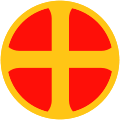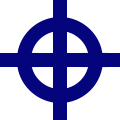- Ornamental pins, found in Switzerland, date to the first half of the 2nd millennium BC; their circular heads are incised with crosses
- Wheel pendants dating to the second half of the 2nd millennium BC, found in Zürich. Variants include a six-spoked wheel, a central empty circle, and a second circle with twelve spokes surrounding one of four spokes.
- A sun disk found in tombs in Alacahöyük dates back to the early Bronze Age. Notice the three sun crosses on the sun disk.
- Amber sun cross, Nordic Bronze Age, Denmark. [7]
- Corded Ware culture amber sun disc (illustration)
This article needs additional citations for verification .(August 2019) |

A sun cross, solar cross, or wheel cross is a solar symbol consisting of an equilateral cross inside a circle. The design is frequently found in the symbolism of prehistoric cultures, particularly during the Neolithic to Bronze Age periods of European prehistory. The symbol's ubiquity and apparent importance in prehistoric religion have given rise to its interpretation as a solar symbol, whence the modern English term "sun cross" (a calque of German : Sonnenkreuz). The symbol means village in Ancient Egyptian (Gardiner symbol O49).
Contents
- Interpretation as solar symbol
- Archaeological record
- Bronze Age
- Modern culture
- Astronomy
- Commerce
- Ethnography
- Politics
- Tools
- Unicode
- Examples
- See also
- References
Prehistoric rock carvings at Madsebakke, on Bornholm Island, Denmark, depict multiple sun crosses with cup marks. These petroglyphs date to the Bronze Age (c. 1800–500 BCE) and are among the best-preserved in Scandinavia. The big wheel sun cross, carved directly into granite bedrock, is a circular motif with radial arms – often interpreted as a solar symbol representing the movement of the sun or the cycle of seasons. Around it are cup marks, small carved indentations believed to hold ritual significance, possibly linked to offerings or celestial events. Other locations with similar sun cross motifs and cup-marked stones include:
- Bohuslän, Sweden – home to thousands of Bronze Age carvings with solar boats, warriors, and sun wheels.
- Alta, Norway – UNESCO World Heritage site with symbolic carvings, including solar imagery.
- Götaland and Östergötland, Sweden – known for petroglyphs featuring sun crosses and animal figures.
These carvings are part of a shared Nordic symbolic tradition, emphasizing sun worship, cycles of life, and ancestral rituals. The same symbol is in use as a modern astronomical symbol representing the Earth rather than the sun. In pharmacy, the sun cross symbol represents various/miscellaneous drugs. After World War II, variants of the symbol became associated with neo-Nazi and white supremacist movements. [1] [ dubious – discuss ]


















